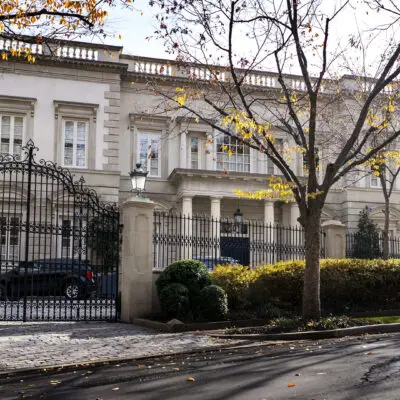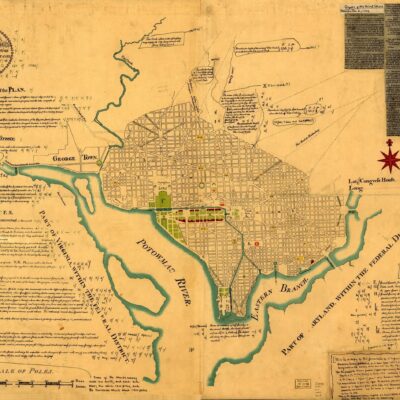Wait, what did you say? The Washington Padres? Yes, that’s right.
This deal was pretty much signed, sealed and delivered when the Washington Post reported it on May 28th, 1973 in an article titled “Baseball’s Back! San Diego Padres Play Here in ’74.”
SAN DIEGO, May 27 (A.P.)–A group of Washington, D.C. businessmen has purchased the San Diego Padre baseball team for a record $12 million from San Diego banker C. Arnholt Smith and will move the team to the capital city for the 1974 season, Smith acknowledged today.
Smith, the principal owner of the team, sold the franchise May 5 in San Diego to a group headed by Joseph Danzansky, Smith confirmed.
A down payment of $100,000 has reportedly been accepted by Smith.
Danzansky, by the way, was the owner of Giant Food, Inc. He also made an unsuccessful pitch to buy and keep the Senators from moving to Texas in 1971. The other key player in this drama was Arnholt Smith, a close personal friend of President Nixon and owner of the United States National Bank in San Diego. At one time, the bank had assets totaling $1.2 billion, but, plagued by countless bad loans, the bank went under. At the time, it was the largest bank failure in history. The IRS was suing Smith for $23 million and he was eventually convicted of embezzlement and tax fraud.
Only $12 million with a $100,000 down payment? Ted Lerner is shaking his head.


Can you imagine how different things would be? Ozzie Smith and Dave Winfield would have started out their illustrious careers playing at RFK Stadium. Washington would have rallied around Roberto Alomar, Fred McGriff, Steve Garvey, Rollie Fingers, Jack Clark, Trevor Hoffman and of course, Mr. Padre, Tony Gwynn. We would have seen two (losing) World Series teams in 1984 and 1998. Hall of Famer Willie McCovey would have even played here during his 1974-76 stint with the team.
Uniforms were even designed (which were ugly as sh*t) and baseball cards listed the team in Washington. Baseball history would be dramatically different in our city.
So what happened? Why aren’t we all Padres fans?
One of the first major roadblocks was the stadium lease between the city of San Diego and the Padres. The team had 15 years left on a 20-year lease and without settlement on their contractual obligation for occupancy and use of the stadium, the team was going nowhere.
By the 1973 All-Star break, the Padres had the worst record in baseball at 33-65 and were an abysmal 29 games behind division leaders, the Dodgers. Washington didn’t care. We just wanted a team back and frankly, we were used to losing with the hapless Senators having just left our city a few years earlier (the Senators didn’t always suck).
I came across another interesting story in the Post, this time from September 21st, 1973. National League owners were not in favor of the move and two were loudly against it.
“I was surprised at the lack of real sentiment expressed at the meeting on behalf of Washington,” the executive was quoted as saying.
He said two owners, identified by the Star-News as Walter O’Malley, of the Los Angeles Dodgers, and Phil Wrigley, of the Chicago Cubs, expressed outright opposition to Washington, while several others questioned “security problems” in the nation’s capital.
Screw you O’Malley and Wrigley … and to the rest of the National League, I’m thoroughly enjoying watching our new team beat up on you guys.
Wrigley’s opposition was based on the fact that Calvin Griffith left for greener pastures and Bob Short also bailed on the city. For him, the fact that two teams were unsuccessful pointed to a city that was unable to sustain a big league club. O’Malley’s was based on self-interest in that another California team, and potential rival, increased the value of his own Dodgers.

Washington had a huge ally in Bowie Kuhn, Commissioner of Major League Baseball and they really needed was 9 of 12 owners to consent to the move.
By December 6th, things truly appeared to be wrapped up in favor of Washington — also happening on December 6th, 1973 … Gerald Ford was confirmed and sworn in as the 40th Vice President of the United States in the middle of the Watergate Scandal.
The National League team owners had met in Houston and voted unanimously to move the team to the Nation’s Capital, provided “certain conditions” were met by December 21st. However, the conditions were not outlined in the Washington Post’s article on December 7th.
At a press conference in the Shoreham Hotel Danzansky said he would meet in Washington “very soon” with Smith, “and judging from previous dealings I would guess we will have no difficulty in finding a mutually satisfactory solution to our problems.”
Chief among the conditions is a plan to indemnify the league against the $12 million in damages the city of San Diego says it will see if its 15-year stadium lease with the team is broken.
…
A nucleus of powerful congressmen on various committees which control the D.C. government have notified the league they are willing to discuss a possible indemnification plan which could involve city or federal funds.
According to all reports, the Padres’ time in San Diego was over and they were destined for D.C. The official National League schedule was released with the new Washington team set for a home opener at RFK Stadium at 2:30 p.m. on April 4th, 1974 against the Phillies.

The city of San Diego was not going down without a fight … a big fight and Mayor Pete Wilson (future California senator, governor and fringe presidential candidate) would strongly vocalize that in the media.
In San Diego, however, Mayor Pete Wilson had no doubts about [what] he will do about the owners’ decision. “We’ll see them in court,” he said in a late afternoon press conference.
“The city will wage war against the league on both the legal and political fronts to keep our baseball team in San Diego,” Wilson declared. “The U.S. Congress, as watchdog of the public purse, has decided that subsidizing the piracy of the San Diego Padres is an urgent national priority, warranting the expenditure of federal taxpayers’ funds.”
Lawsuits were initiated by San Diego city attorneys, seeking ridiculous damages of $72 million for breach of contract and the National League was named party to the suit. Needless to say, the rest of the owners were getting cold feet, reconsidering their unanimous vote of approval, given the potential financial consequences. Meanwhile, Arnholt Smith’s financial dire straits were escalating due to the implosion of his bank and he was now being investigated and pursued by the IRS, SEC and countless large creditors to whom he owned money. In short, he was in a really bad place and needed to unload the Padres quickly.
Danzansky and his ownership team was just unable to pull together an acceptable deal given the risky circumstances surrounding the potential legal implications. At well past the 11th hour (January 1974), a local hero emerged for San Diego, with the angelic glow of the golden arches behind him. Ray Kroc, the über-rich head of McDonald’s — his estimated net worth at the time was $400 million — swooped in and agreed to purchase the team from Smith and keep the team in the city. (Here’s what San Diego looked like back then.)

He paid the asking price of $12 million (FYI, Steinbrenner’s group paid only $8.8 million the year before for the Yankees). Kroc signed a lease with the city to keep them in town through at least 1980. He also agreed to terms which would require him to pay a large penalty to the city should he choose to relocate the team and in return, he received a larger share of parking and concession revenue at the stadium.
The Padres stayed put and 10 years later found themselves in the World Series. Danzansky’s concession (not really) was that Washington and his ownership group would be at the top of the list for an expansion team. That didn’t really work out either, because Denver, Miami, Phoenix and Tampa (F-ing Tampa?) worked those deals. The nation’s capital would have to wait 31 more years before the arrival of the Washington Nationals at RFK Stadium.
Our city has waited a long time for a team … and now we have a great winning team.









![Capital Transit demonstration run of a Twin Coach articulated bus (a model they did not end up using), April 3, 1948. This turnaround is still used by buses today [photo by Robert S. Crockett].](https://ghostsofdc.org/wp-content/uploads/sites/7/2015/12/10896004463_3f7d28bb16_o-400x400.jpg)









